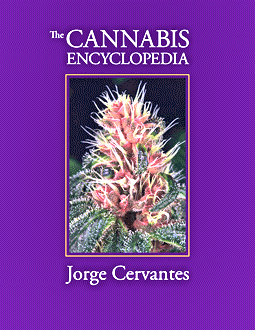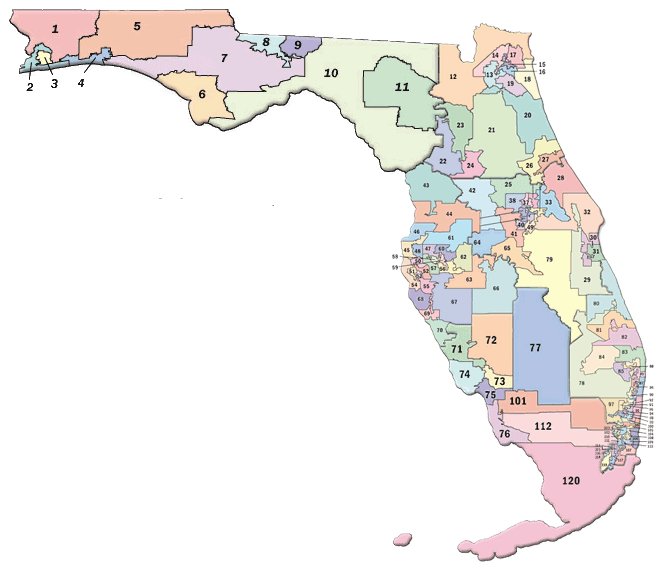April 9 By Fred Gardner A beautifully produced 596-page “Cannabis Encyclopedia” by Jorge Cervantes arrived just as we were looking for a graphic to run with a letter to O’Shaughnessy’s from a grower bedeviled by Russet Mites up where the Klamath River runs into the ocean.
The Encyclopedia provided two usable pix —a blown-up photomicrograph of the disgusting little creatures, and a photo by Karl Hillig showing them on a leaf petiole.
This is what O’Shaughnessy’s correspondent, A.J., had written from northernmost California:
I saw that you wrote an article about a trimmer getting sick from Avid. Well I thought I’d write you because Avid is now this looming element in my life and I thought you might be interested in this. So Russet Mites and/or Broad Mites seem to be this years epidemic in my small town. They are micrcoscopic, easy to misdiagnose and can take out an entire garden. The can also spread from dried product to infest gardens. The most common product, it seems, that is used to defend against these pests is Avid. It’s available under the counter at garden stores and via Amazon. I have the pest and Avid was recommended to me but when I got it in the mail and read the instructions I had serious concerns about using it. I am going to continue to pursue other routes of action because it seems so toxic, to the applicant, the environment and obviously the end user. However, I’m terrified that if I don’t use it I’ll lose everything! Maybe this isn’t a new thing, but it’s new to me and this community. Also at the garden store the guy who I talked to about it seemed to agree that it was this year’s plague and most people are reaching for the highly toxic stuff.
We asked A.J. what she knew about the destruction wrought by the hemp russet mite. She replied:
They stunt the plant, the leaves turn yellow and drop while the mites suck the resin out of the developing flowers. Amazing how destructive these invisible pests are. There are a few things the leaves will do to give you a sure ID and of course watching the flowers shrivel tells you what you you’re dealing with. Oh, and when you hear that your neighbors have it, it’s usually a good sign that you have it, too. It can easily be confused as a nutrient deficiency, rust, anything, because they are microscopic. It also spreads fast. I was told by my friend that I should either use Avid or kiss my garden good bye. Wow!
I’ve been doing lots of research on this and it turns out that in Canada and New Zealand Avid is used on commercial food crops and in some cases it’s used in the US ,too. It is regularly sold under the counter at garden centers, i read an interesting article written by someone in Berkeley about this. The family of the mite is the Eriophyoid and I found the most interesting information by googling that. These things spread easily, by wind, on clothes, etc., AND the eggs can overwinter. Who needs CAMP when you got russet mites?
On webforums addressing this, lots of the posts are from this year and last year. I also read that Colorado is dealing with this big time. That’s not surprising. One thing I’m thinking about are seasonal workers (who are mostly women) who deal with this stuff day after day after day, without properly protecting themselves from residues that they probably don’t even know are present. The warning label on Avid directly says that exposure could lead to birth defects! I’ve never asked an employer what they’ve sprayed on their plants, how long ago the application was applied and how I can protect myself from it’s affects. I’ve never thought about it before but it’s a serious concern.
I’ve decided to not spray with Avid and try all of the organic stuff i have around until i run out. I just don’t have the money to keep at it, especially since I don’t have confidence it’s going to help. I haven’t found any place to buy those beneficial mites, but I’ll keep my eyes and ears open. I heard last night that “everyone on the river” has the russet mites. I think this is a bit of an exaggeration but it leads me to believe that is incredibly widespread.
And now we can turn to the “Diseases and Pests” chapter of the Cannabis Encyclopedia and get the scoop on Hemp Russet Mites (Aculops cannabicola) from botanist Karl Hillig:
Identify: Hemp russet mites are not well-known but this appalling pest is growing in infamy because it is so hard to control. The mites are very small reaching only 0.2 mm in length and they have just two pairs of legs attached to their pale beige bodies. Even though hemp russet mites are virtually impossible to see with the naked eye, they are easy to distinguish from other destructive mites because they leave no webbing. At 800 F (270C) hemp russet mites achieve a 30-day life cycle.
Damage: Feeds on all types of cannabis plants. They live and feed mainly on leaves, petioles, and meristems. Feeding damages causes leaflets to curl at eduges followed by chlorosis and necrosis. Leaves and petioles become brittle. Infestation turns leaves beighe with hemp russet mite bodies! Mites feed on female stigmas rendering them sterile. They also consume resin glands which can reduce resin production severely. Hemp russet mites feed on cannabis plants until host is dead. They congregate on the upper part of the plant as it dies. Hemp russet mites vector viruses.
Cause: Introduced to gardens by unsanitary practices, contaminated stock and bad luck. Hemp russet mites hide on plants indoors and in greenhouses. They are believed to overwinter on contaminated seed indoors and outdoors. The minute mites spread easily to nearby plants by splashing water. Wind also carries them greater distances.
Prevention: Keep garden area clean and disinfected. Introduce only pest-free stock into gardens, Disinfect seeds. Keep the garden below 700F (2210C) and below 50% humidity to slow reproductive process. Removes seriously damaged foliage and plants from garden.
Control: Biological: The fungus Hirsutella thompsonii is a pathogen to hemp russet mites, but I have not seen it available commercially.
Sprays: Miticides and sulfur sprays are somewhat effective. Make sure to get complete foliage when spraying.
Full Disclosure: I’m the co-author, with John McPartland, of the Cannabis Encyclopedia’s history chapter, and I appreciated the opportunity. —F.G.
PS From the publisher, George Van Patten, also known as Jorge Cervantes:
Here is a link to my site explaining more about the book,
http://ww2.marijuanagrowing.com/category/cannabis-encyclopedia/
Here is the amazon link to it,







